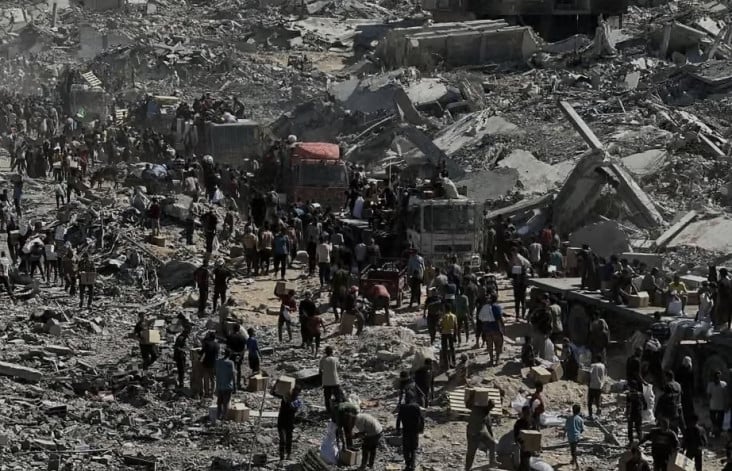GAZA, Sketsa.id – A U.S.-brokered truce designed to bring a moment of respite to the war-ravaged Gaza Strip is hanging by a thread. The agreement, which came into effect on October 10, is being challenged by a deadly cycle of accusations, airstrikes, and a staggering number of civilian casualties.
The fragility of the peace was starkly highlighted by Israeli Prime Minister Benjamin Netanyahu himself. In a speech to the Knesset on Sunday, he revealed a shocking statistic: in a single day, Israeli forces had dropped 153 tons of bombs on Gaza. This announcement came as he defended military actions that, according to the Gaza Media Office, have killed at least 97 Palestinians and wounded 230 others since the truce began.
“During the truce, two soldiers fell,” Netanyahu stated, facing interruptions from opposition lawmakers. “We attacked them with 153 tons of bombs and struck dozens of targets across the Gaza Strip.”
A Cycle of Blame and Denial
The immediate trigger for Sunday’s intense bombardment, according to the Israeli Defense Forces (IDF), was an attack in Rafah where Hamas fighters allegedly used anti-tank rockets, killing two Israeli soldiers. Israel labeled this a violation and launched what it called a “large and extensive wave” of attacks across Gaza.
However, Hamas’s armed wing, the Qassam Brigades, offered a sharp denial. A spokesman stated the group had no knowledge of any clashes in Rafah, a area under Israeli control, and emphasized they had no contact with fighters there since March. They reiterated their commitment to the ceasefire agreement.
This incident is not the only point of contention. Israel has also accused Hamas of delaying the return of the bodies of 28 captives who died during the bombing. Hamas counters that the sheer scale of destruction makes recovery efforts painstakingly slow, noting that around 10,000 Palestinian bodies are also still trapped under the rubble created by Israeli bombs.
The Human Cost Beyond the Headlines
Behind the political statements and military claims lies a deepening human tragedy. The numbers tell a grim story:
-
Over 68,200 killed and 170,200 injured in Gaza since October 2023.
-
1,139 people killed in Israel during the Hamas-led attack on October 7, 2023.
For families in Gaza, the supposed truce has offered little safety. On Friday, an Israeli strike hit a civilian vehicle, killing 11 members of the Abu Shaaban family—seven children and three women—as they tried to reach their home in Zeitoun.
The challenges for those who survive are immense. With entire neighborhoods erased, many displaced Palestinians have no home to return to. An unmarked “yellow line” drawn by the Israeli military creates invisible boundaries, where crossing risks being shot. Rough maps suggest this line leaves about 58% of Gaza under Israeli control.
What Was in the Truce Deal?
The 20-point proposal, mediated by the U.S., Qatar, Egypt, and Turkey, envisioned a path toward a more lasting calm. Key points included:
-
An end to hostilities by both Israel and Hamas.
-
The release of all captives held in Gaza, both living and deceased, in exchange for about 2,000 Palestinian prisoners.
-
Hamas stepping aside from governing Gaza, to be replaced by an independent technocratic Palestinian government.
-
A full Israeli withdrawal from the territory.
Hamas has expressed acceptance of the core terms regarding captives and governance. A Hamas official stated that remaining demands, such as disarmament, need to be “addressed within an inclusive Palestinian national framework.”
Is the Truce Still Alive?
Despite the violence, U.S. officials have stated the truce framework remains in place. Following Sunday’s attacks, the Israeli military said the ceasefire had been “resumed,” alongside the entry of aid.
Yet, on the ground, the reality is different. Aid remains severely restricted, with Israel reportedly allowing only half the agreed number of trucks. The promise of a full Israeli withdrawal seems distant, with officials speaking of maintaining a “buffer zone” indefinitely.
For the people of Gaza, the truce feels less like a promise of peace and more like a brief pause in an unending nightmare. As the world watches the accusations fly, families continue to dig through rubble, searching for their loved ones and for a safety that remains agonizingly out of reach. (*)




